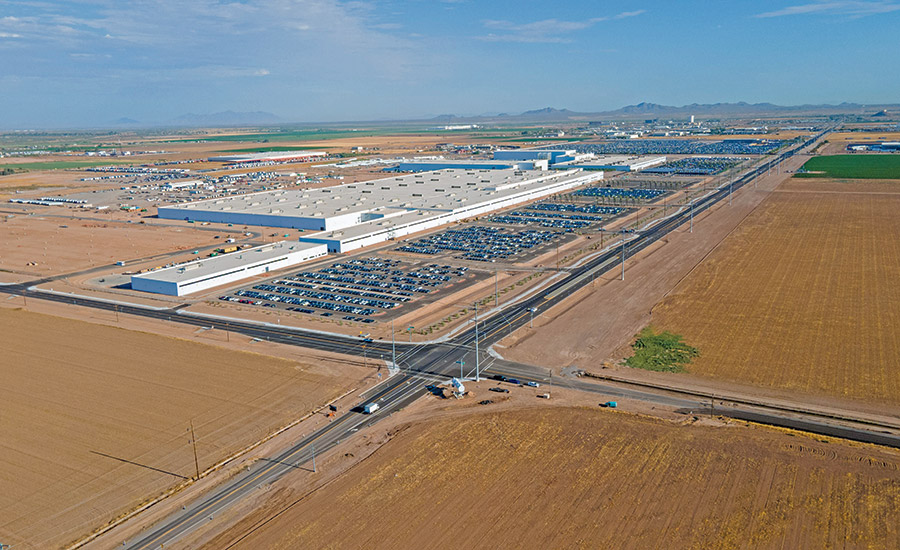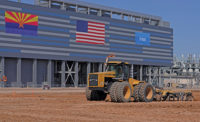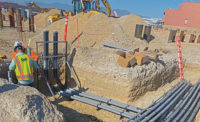Related Link:
ENR Southwest 2023 Top Specialty Contractors
Despite recession fears and high interest rates as well as supply chain delays and continuing labor shortages, specialty contractors in the Southwest are applauding last year’s productivity levels and anticipating a continued burst of activity through 2023.
In Arizona, specialty construction has remained dynamic over the past year across all sectors. “Despite lingering supply chain issues and occasional economic uncertainty, our members have continued to build Arizona at a breakneck pace,” says Josh Umar, executive director of the 180-member Arizona chapter of the American Subcontractors Association. “Most specialty contractors have more work available than they can feasibly bid on and often can afford to be selective about the jobs they accept.”
Trending in Arizona are multifamily, health care and manufacturing projects—especially for microchips. “Because of the strength of the market here, we’ve also seen a lot of consolidation with member firms buying other companies, and even a meaningful amount of out-of-state venture capital firms acquiring Arizona trades businesses,” Umar adds.
Derek Wright, president and CEO at Suntec Concrete, says an increased focus on infrastructure development and sustainable construction practices has meant specialty contractors, especially concrete firms, have seen steady demand for their services.
The Phoenix-based contractor posted Arizona revenue of $556 million for 2022.
Recently completed Suntec projects in the state include Project Lucid in Casa Grande and the Ross Distribution Center in Buckeye.
Demand for construction in Nevada also remains strong, says Ashley S. Jager, marketing and business development director for Las Vegas-based Commercial Roofers. The firm reported $55.96 million in revenue for Nevada projects last year and took home the Nevada Contractors Association (AGC) Subcontractor of the Year award for the second time in four years.
Jager adds that throughout 2022 and 2023, the company has received almost three times the amount of RFQs on new construction projects compared with 2021. “Our production and installation work remained extremely high in 2022 and 2023, and we have a significant backlog of work well into 2025,” she says.
Sean Howard, project manager with Commercial Roofers adds: “While the news stations kept sounding alarms about impending recessions, requests for roofing bids and proposals seemed to hold steady, if not slightly increase. In the last few months, those requests have picked up, putting us on pace for a very strong first half of next year.”
Last year the roofing contractor completed a $2.7-million contract as part of the IMC World Market Center Building A, and the firm is currently constructing the CCSD Northeast Career & Technical Academy. Both projects are in Las Vegas.
Projects underway for both the upcoming Formula 1 race and the 2024 Superbowl have kept Las Vegas contractors busy as the city prepares to welcome more than 100,000 visitors for the events, says Tyler Bonwell, president, MMC Contractors.
MMC is the mechanical trade partner for the Formula 1 Las Vegas Grand Prix Paddock Building; the company’s $20-million scope includes the mechanical construction for the nearly 300,000-sq-ft venue, which will house owners’ suites, observation decks, garages and more.
The construction process was a short one-year period, Bonwell says, and that compressed lead time “was an opportunity for our team to be brought into the planning and construction process very early ... to mitigate the risks involved with a constrained timeline and construction schedule.”
MCC generated $105.27 million in revenue in 2022, due in part to the $10.4-million mechanical scope on the Centennial Hills Hospital Tower Addition.
Looking Ahead
ASA’s Umar says specialty contractors will continue to contend with workforce shortages into the near future. “They are extreme, and the demographics within the industry don’t look to turn around any time soon,” he adds.
“We are working closely with our trade partners to expand our recruiting efforts to include colleges, universities and trade schools that we have not previously focused on,” MMC’s Bonwell says.
Umar says that “dysfunction and partisanship at higher levels of government” is also factoring into current industry conditions. “Issues that used to be state-level concerns have now spilled out into municipalities across the state as stakeholders seek legislative solutions,” he says. “It’s made for some strange, if welcome, bedfellows at times. It’s also taxed the ability of advocacy groups to keep pace, as a policy that may have been debated in a single place and time—the state legislature—now must be addressed in city councils all across Arizona.”
Umar and his group anticipate slowdowns in some areas, but the pace of the last year or two has resulted in large backlogs, which he says should buoy the specialty contractors to a certain extent.
“Federal infrastructure funds will begin pouring into the state soon as well, and that will only help, especially for those working in heavy civil, education and the like,” he says.
Innovations will boost Commercial Roofers’ upcoming work; the contractor has implemented a new operating software platform and is using GPS. It is also seeking more LEED projects and aligning with manufacturers involved with green projects, Jager says. “Entitlement and permitting activity seem to be fairly steady for each authority having jurisdiction around the Las Vegas valley, [and] we don’t anticipate construction activity to slow significantly in the near future,” she says.
“The next year holds promising opportunities for specialty contractors,” adds Wright. “As the global economy continues to recover and investment in infrastructure remains a priority, we anticipate a continued demand for our specialized services.”





Post a comment to this article
Report Abusive Comment